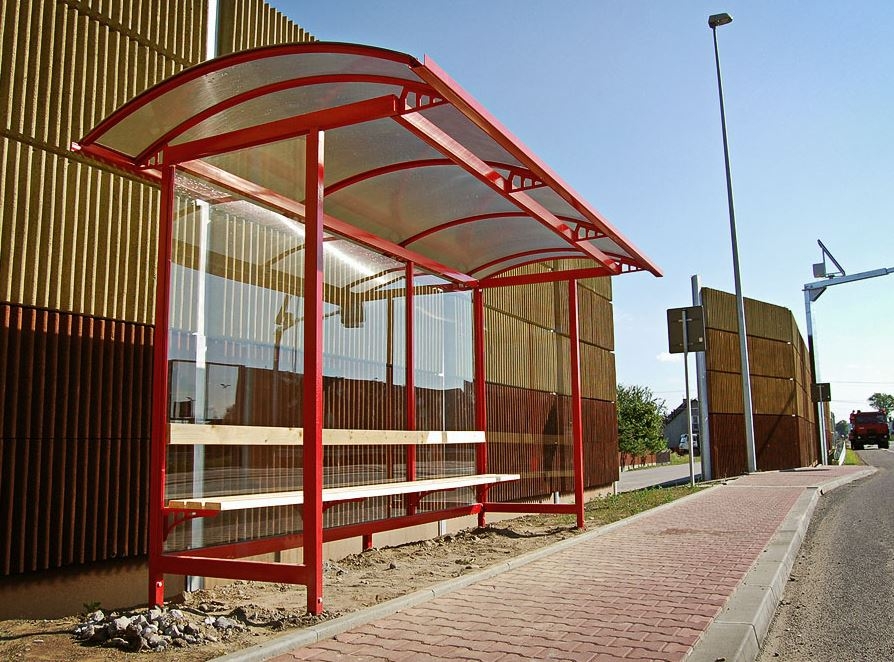Public transport is a cornerstone of urban mobility. Using buses offers an efficient, cost-effective, and environmentally friendly alternative to personal cars. However, the success of a public transportation system depends significantly on the quality of its infrastructure, which includes bus shelters as one of the primary user contact points with the transport system. Bus shelters play a crucial role in enhancing the public transportation experience by providing passengers comfort, safety, and convenience.
A well-designed bus shelter offers more than just a place to wait for a bus – it can turn your journey into a pleasant, secure, and comfortable experience. Effective shelters protect passengers from adverse weather conditions, provide comfortable seating, and ensure safety and accessibility for all users. By incorporating advanced design elements and leveraging modern technology, bus shelters can significantly improve the overall appeal of public transport and encourage higher ridership.
So, what design elements can enhance the functionality and appeal of bus shelters?
Good Frame Design
One of the primary functions of a bus shelter is to protect passengers from adverse weather conditions. Effective shelters should provide protection from rain, wind, and direct sunlight. Ideally, a bus stop would have a roof, sides, and a back panel to protect passengers from strong wind and rain. Some designs, like our Emerald Bus Shelter, even go a step further and come with a front panel for extra protection.
A solid frame design that can accommodate a roof and sides is paramount. Steel is a great material for bus shelter frames, and polycarbonate is often used because of its durability and transparency. This allows for natural light while shielding users from weather elements.
Seating and Comfort
Providing seating is essential for improving user experience. This is especially important in areas where bus waiting times are longer and bus options are fewer. Depending on location and how busy the place gets, a shelter should have enough seating to accommodate a decent number of people. Having seats also ensures that passengers like kids, pregnant women, older people, and anyone with disabilities will be a lot more comfortable.
When it comes to materials, there are many options. Our Topaz Bus Shelter, for example, offers simple timber plank benches, moulded plastic seats, and epoxidated laminate benches. They are all excellent choices—high-quality and easy to maintain—so whichever one you select will be a good addition to your shelter.
Safety and Security
Safety is a crucial aspect of bus shelter design. Shelters should be well-lit to enhance visibility and deter criminal activities. Some of our models, like the Halton Bus Shelter, can be ordered with in-built solar LED lighting for this exact purpose. The use of transparent materials can help passengers and drivers see into and out of the shelter, increasing the sense of security. Additionally, some shelters can incorporate security cameras.
Accessibility
To ensure inclusivity, bus shelters must be designed to accommodate all users, including those with disabilities. Features such as ramps, if the surface is uneven, and tactile paving can help make shelters more accessible. Shelters should also be positioned at a suitable height and distance from the curb to facilitate easy boarding and alighting from buses.
Information Display
Providing clear and accurate information is vital for enhancing the user experience. Shelters should provide clear and accurate information on bus schedules, routes, and any service changes. They can also include useful maps, especially if they’re located in tourist areas where visitors would appreciate that information. QR codes for mobile access to schedules and route maps are also a modern touch that can improve user convenience.
Designs like our Ruby Bus Shelter can be manufactured with timetable cases plus additional advertising cases, which can be used not just for advertising but also for any information campaigns the local council may want to publicise or for additional information about the transport system.
Aesthetic Appeal
Aesthetically pleasing bus shelters can contribute to the overall attractiveness of a city’s public transport system. Incorporating local art, design, and cultural elements can make shelters more appealing and reflect the community’s identity. This not only improves user experience but also promotes civic pride. The advertising case mentioned above is an excellent way to display local art on a temporary basis.
Steel or galvanised steel bus shelters can be powder-coated with a RAL colour to either stand out, if that’s the effect you’re looking for, or blend in beautifully with the environment.
Sustainable Features
Sustainability is an increasingly important consideration in urban design. Using recycled or easily recyclable materials for constructing bus shelters helps reduce waste and environmental impact. For example, steel is an excellent material choice due to its high recyclability. Steel can be recycled indefinitely without losing its strength or durability, making it a sustainable option for long-lasting bus shelters that won’t need replacing anytime soon.
Incorporating solar panels into the design of bus shelters is another way to boost its sustainability credentials. Bus shelters benefit from lighting, and solar panels are a great sustainable energy source that can power them. Solar-powered shelters reduce reliance on non-renewable energy sources and decrease the overall carbon footprint of public transportation infrastructure.
By incorporating these design elements, bus shelters can significantly improve the functionality and user experience of the public transport system. Thoughtful and user-centric design can make waiting for the bus a more comfortable, safe, and enjoyable experience, ultimately encouraging more people to choose public transport over other modes of travel.
